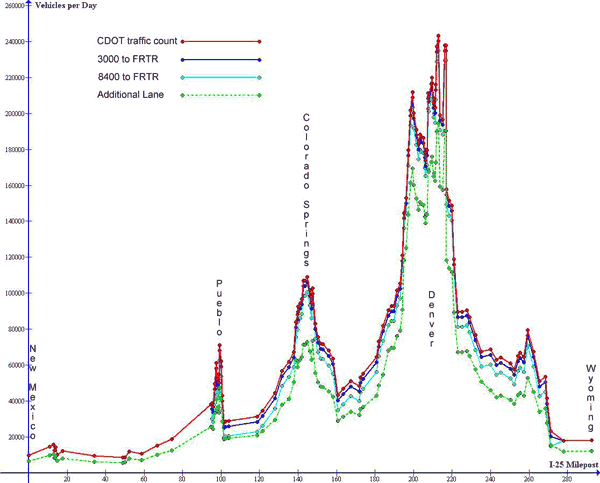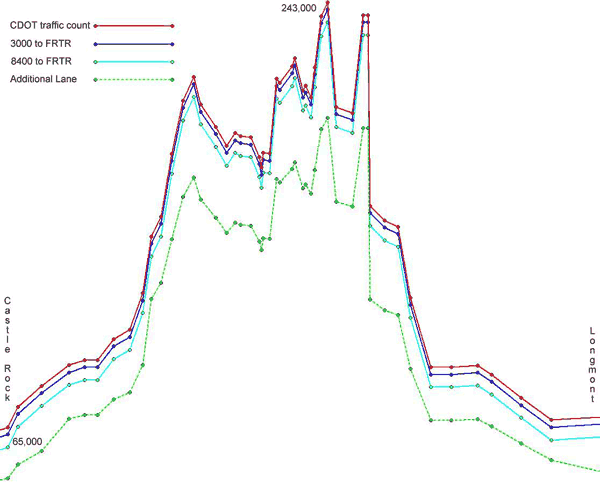
Super Slab
Below is an excellent graph, clearly showing exactly what we have been saying for years – the traffic on I-25 is heading to Denver and a by-pass some 25+ miles east will not alleviate the traffic problems currently being experienced in the Denver Metro area.
The question still remains: How do we force Prairie Falcon to “fish or cut bait”?
Peace and grace,
Sharon Croghan
Graph - I-25 through Denver & Super Slab, aka Prairie Falcon Expressway, aka ?
There has still been no word from CDOT that the Front Range Toll Road Company has requested permission to do an environmental study. But there have been some indications that the engineering company Parsons Brinckerhoff (www.pbworld.com) may be working on the project. PB is a big company that has done all sorts of transportation projects beginning with the first subway system for New York City 120 years ago. The Super Slab used PB's Company 39 division (www.company39.com) to develop their Prairie Falcon Parkway website (www.prairiefalconparkwayexpress.com).
We're coming up on three years of involvement with the Super Slab and the debate has gone off in various directions at various times. Eminent domain, corridor width, corridor location, lack of notification and many others. We've succeeded in passing legislation to deal with many of the issues concerning toll roads in general. But as far as the Super Slab proposal goes it is time for Ray Wells to face facts, his road wouldn't help the traffic problems on I-25.
The CDOT website has tables of traffic counts at points all along the highways of the state. I've plotted the average daily traffic figures for I-25 for its entire length from mile 0.0 at the New Mexico state line to mile 298.9 at the Wyoming line. That’s the red line on the graph. The dark blue line shows what the result would be if 3,000 vehicles per day took the Super Slab route between Wellington (mile 278) and Stem Beach south of Pueblo (mile 95). The number 3,000 is significant because that is the number of vehicles passing all the way through the Denver metro area daily according to Will Toor, chairman of the Denver Regional Council of Governments. Toor told the Denver Post that only 3,000 of the cars traveling I-25 in Denver (243,300 at mile 213) pass through, the rest are local traffic. So the very best (and extremely unlikely) case for the Super Slab would be if all 3,000 of those vehicles turned off at Pueblo or Wellington and took the Slab instead of I-25. That’s what the dark blue line shows. It’s hard to see because it is barely different from the red line. (continued below)


The light green dashed line shows the effect of adding one lane in each direction to I-25. Obviously, adding a lane doesn’t reduce the number of vehicles but by giving them room to spread out it reduces the number in each lane. Increasing the number of lanes from 4 to 6 leaves 4/6 or 66% as many cars in each lane as there were before. Increasing from 8 lanes to 10 leaves 8/10 or 80% in each lane. The CDOT website shows the number of lanes at every point of I-25. It varies from 4 in less populated areas to as many as 10 on one stretch in Denver. Those figures were used to compute the green dashed line to show the reduction in congestion that adding a lane would give.
The busiest section of I-25 is 8 lanes wide and carries 243,000 vehicles per day. Adding a lane in each direction reduces the traffic in each existing lane by 20%. It would take 48,000 vehicles out of existing lanes. Compare that to the reduction of 3,000 or 8,400 which are the best possible (but wildly improbable) results from building the Super Slab. The idea of outsourcing the Front Range traffic problems to the eastern plains sounded promising at first but it is wishful thinking. We need to put the pavement under the traffic and not 30 miles away from it. Projects like T-REX and COSMIX are what is needed, not a bypass to connect Wyoming and New Mexico.
Rob Dougherty, Pueblo County
www.stupidslab.com
Good Neighbor Committee
P.O. Box 155 - La Salle, CO 80645
info@goodneighborlaw.com
| Good Neighbor Law© 2006 |